Comprehensive Treatment Strategies for Ruptured Lumbar Discs
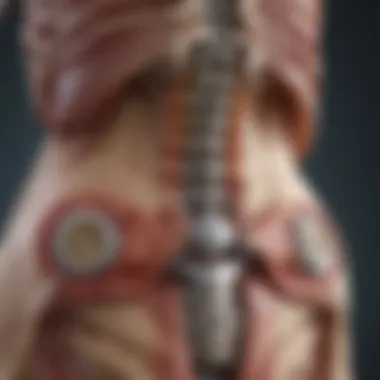
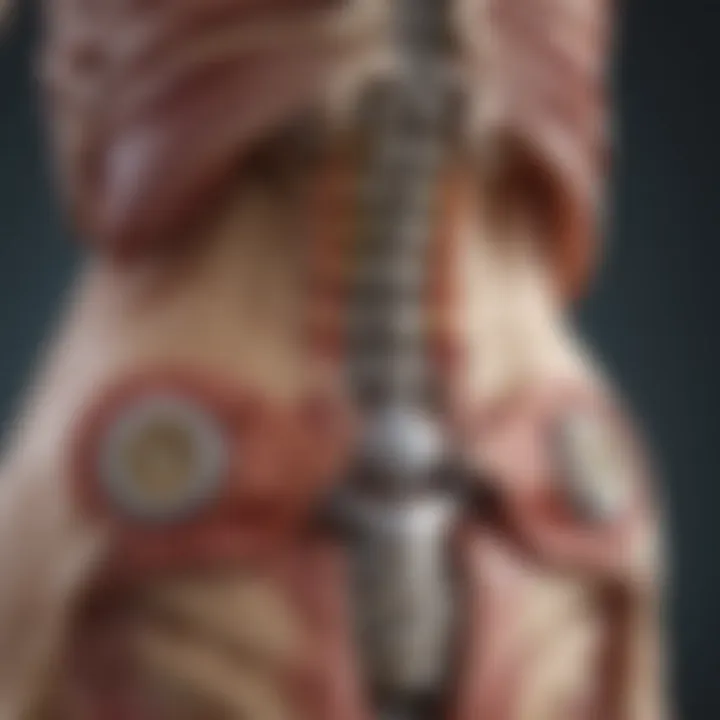
Intro
Ruptured lumbar discs represent a significant health issue, often leading to debilitating pain and affecting mobility. Understanding the comprehensive treatment strategies available is crucial for both medical professionals and patients. This article aims to provide a detailed examination of these treatment options, from conservative management to advanced surgical interventions. It will also discuss mechanisms of disc rupture and the variety of symptoms associated with this condition. The objective is to deliver evidence-based information that can assist in tailoring treatments to each patient's unique circumstances.
Research Overview
Summary of Key Findings
Research has shown that a considerable portion of adults experience lumbar disc issues at some point in their lives. Studies have identified a range of treatment strategies that can be effective. Conservative treatments often include physical therapy, medication, and lifestyle modifications. These approaches can yield significant improvements for many individuals. In cases where conservative management fails, surgical interventions may become necessary. Techniques such as microdiscectomy and spinal fusion are common and have reported high success rates in carefully selected patients.
Importance of the Research
Understanding treatment strategies for ruptured lumbar discs is vital for various reasons. First, it equips medical professionals with knowledge to make informed decisions regarding patient care. Second, it provides insights for researchers to explore innovative treatment avenues. Lastly, it empowers patients with information to better understand their treatment options and recovery processes, ultimately improving outcomes.
Methodology
The methodology for this exploration is based on a review of existing literature, clinical guidelines, and recent advancements in spinal health treatments. This approach ensures a well-rounded perspective on the subject.
Study Design
The studies included in this review generally employ a mix of observational and interventional designs. This allows a comprehensive understanding of both the effectiveness of treatments and the experiences of patients undergoing various interventions.
Data Collection Techniques
Data collection is typically conducted through surveys, clinical trials, and retrospective chart reviews. These techniques gather quantifiable data on treatment outcomes, patient satisfaction, and symptom relief. The analysis of this data contributes to the ongoing development of treatment strategies for ruptured lumbar discs.
Understanding Lumbar Disc Rupture
In the realm of spinal health, understanding lumbar disc rupture is fundamental. It forms the foundation for recognition, assessment, and management of this common yet complex condition. A lumbar disc rupture occurs when the disc, which acts as a cushion between the vertebrae in the lower back, becomes damaged or displaced. This event can lead to significant pain and disability. Informed comprehension of the anatomy and mechanisms involved is essential for medical practitioners and educators alike.
Anatomy of the Lumbar Spine
The lumbar spine comprises five vertebrae, labeled L1 to L5. These vertebrae support much of the body's weight and allow for a range of motion. Each vertebra is separated by an intervertebral disc, which consists of a tough outer layer known as the annulus fibrosus and a soft, gel-like inner layer called the nucleus pulposus. This design allows the discs to absorb shock and maintain spinal flexibility.
Key points about the lumbar spine anatomy include:
- Structure: The lumbar spine is uniquely structured to endure stress.
- Function: It supports both posture and movement.
- Role of Discs: The discs play a vital role in providing stability.
Causes of Disc Rupture
Understanding the causes of disc rupture is critical for prevention and treatment strategies. Several factors can contribute to this condition, including:
- Age-related degeneration: Discs naturally lose hydration and elasticity over time.
- Injury: Acute trauma, such as lifting heavy objects improperly, can cause a disc to rupture.
- Repetitive strain: Activities that involve repeated stress to the spine can lead to disc damage.
- Genetic factors: Certain hereditary conditions may increase the risk of disc degeneration.
Each cause highlights the importance of adopting preventive measures and understanding personal risks. Addressing lifestyle factors can mitigate the likelihood of lumbar disc issues.
Pathophysiology of Herniation
The pathophysiology of herniation explains the process by which a disc can rupture and impinge on nearby spinal nerves. When a disc herniates, the nucleus pulposus pushes through a tear in the annulus fibrosus. This may create pressure on adjacent nerve roots, which can result in pain, numbness, or weakness in the legs.
Common pathophysiological mechanisms include:
- Biomechanical stress: Excessive loads on the spine may exceed the disc's capacity to withstand them, causing failure.
- Inflammatory processes: Chemicals released during herniation can incite nerve inflammation, compounding the pain experience.
The understanding of herniation mechanisms not only sheds light on patient symptomatology but also informs targeted treatment strategies.
In summary, grasping the nuances of lumbar disc rupture is vital for effective management and recovery. Each component—from anatomy to the causes and the underlying pathological processes—shapes the approach to treatment and rehabilitation.
Clinical Presentation
Understanding the clinical presentation of ruptured lumbar discs is crucial in determining the right treatment approach. Identifying the symptoms and the technique of diagnosis allows medical practitioners to assess the severity of the condition and formulate an effective treatment plan. Proper recognition of these elements leads to timely interventions, minimizing chronic pain and disability among patients.
Common Symptoms
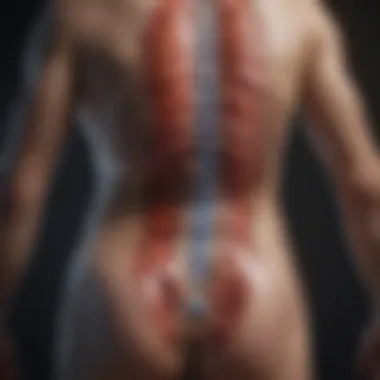
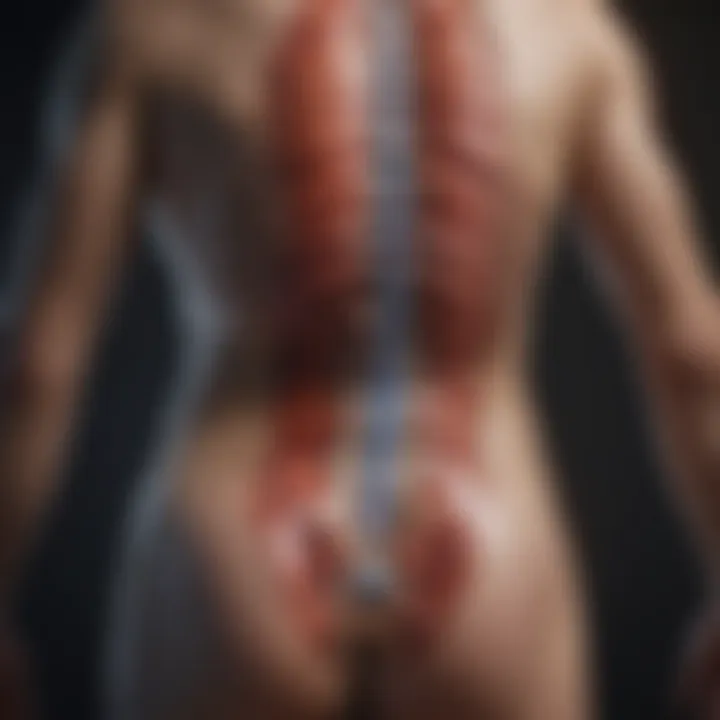
Patients with a ruptured lumbar disc often experience distinct symptoms. The most frequent one is lower back pain, which may radiate down the legs, a condition referred to as sciatica. This pain may range from mild discomfort to intense, debilitating pain, impacting daily activities significantly. Other symptoms include:
- Numbness or tingling: This often occurs in the legs or feet, reflecting nerve involvement.
- Weakness: Some patients may notice weakness in their legs which could hinder their mobility.
- Difficulty in movement: Activities such as bending, lifting, or even standing may exacerbate symptoms, signaling changes in spinal mechanics.
These signs are not only important for diagnosis but also for determining the urgency of treatment required.
Diagnostic Techniques
Diagnosing a ruptured lumbar disc involves a thorough clinical assessment, often supplemented by physical examinations and imaging studies. Each technique offers valuable insights into the patient's condition, guiding healthcare professionals in crafting appropriate management strategies.
Physical Examination
The physical examination is a fundamental part of the overall diagnostic process. It focuses on assessing mobility, strength, and reflexes. A key characteristic of this examination is its immediacy; healthcare providers can evaluate the patient in real time, making it a beneficial first step in the diagnosis.
A unique feature of physical exams involves specific maneuvers, such as straight leg raising tests, which can provoke symptoms indicative of nerve impingement. The advantages of these examinations include their low cost and the ability to provide immediate feedback about the patient’s physical condition. However, their limitations are evident; physical examinations alone may not offer comprehensive data on the disc’s structural integrity.
Imaging Studies
Imaging studies complement the physical examination by providing detailed images of the spine, thus confirming the diagnosis. Magnetic Resonance Imaging (MRI) is often considered the gold standard. It highlights the condition of the discs and can discern between ruptured and bulging discs, making it a popular choice for healthcare providers.
A unique feature of imaging studies is their non-invasive nature, allowing for extensive information about spinal anatomy without the need for surgery. The primary advantage lies in their precision; they can reveal hidden issues that a physical examination might miss. However, some disadvantages exist, such as their higher cost and the time required for scheduling and interpretation.
In summary, both physical examinations and imaging studies play pivotal roles in the clinical presentation of ruptured lumbar discs. Properly utilizing these techniques improves the accuracy of diagnosis and the overall effectiveness of treatment.
Initial Treatment Approaches
Initial treatment approaches for ruptured lumbar discs are crucial as they lay the foundation for recovery and long-term management. These methods prioritize conservative options, recognizing that surgery should be a last resort. The benefits of starting with non-invasive strategies include reduced risk of complications, shorter recovery time, and the potential for significant relief without the need for surgical intervention. Effective management at this stage can lead to improved quality of life and help prevent recurrent issues.
Conservative Management
Physical Therapy
Physical therapy plays a pivotal role in the treatment of ruptured lumbar discs. It focuses on strengthening the muscles that support the spine, which can alleviate pressure on the affected area. One key characteristic of physical therapy is its individualized approach, where therapists design tailored exercise programs specific to a patient’s condition and needs. This strategy is beneficial because it empowers patients to regain mobility and function gradually.
The unique feature of physical therapy is that it serves as both a rehabilitative and preventive measure. It reduces pain while simultaneously enhancing spinal stability. Some advantages include improved range of motion and the development of core strength. However, it may require consistent commitment and can be time-consuming. Patients might find the need for regular sessions inconvenient, and progress can sometimes be slow, which may affect motivation.
Medications
Medications are another key component of conservative management for ruptured lumbar discs. They are often prescribed to manage pain and inflammation, helping patients to perform daily activities with more ease. A notable aspect of medications is their rapid action; for instance, nonsteroidal anti-inflammatory drugs (NSAIDs) can provide quick relief from acute pain.
The primary characteristic of medications is their ability to work in conjunction with other treatments, such as physical therapy. They create a window in which patients can experience better mobility and participate more fully in rehabilitation. One unique feature is the variety of options available, from over-the-counter remedies to prescription medications. The advantages include immediate symptom management, but there are also disadvantages. Long-term use of medications may lead to side effects or dependency. Careful monitoring and consultation with a healthcare provider are necessary to mitigate these risks.
Lifestyle Modifications
Lifestyle modifications are vital in maintaining long-term spinal health following a lumbar disc rupture. They encompass several practical changes that patients can implement in their daily routines.
Activity Modification
Activity modification involves adjusting daily habits to prevent further strain on the spine. This could include avoiding heavy lifting or avoiding prolonged sitting. A key characteristic is its practical applicability; these adjustments can be made easily by individuals in their everyday lives. This proactive measure is beneficial because it encourages patients to take control of their recovery process.
One unique feature of activity modification is its immediate impact on pain management. By altering activities, many individuals experience significant relief. However, the downside may be that some people find it challenging to adapt long-established routines and may face frustrations in changing their lifestyles.
Ergonomic Adjustments
Ergonomic adjustments focus on creating a work and home environment that promotes spinal health. This could involve using chairs with proper support or adjusting desk heights to reduce strain. One notable aspect of ergonomic adjustments is their focus on prevention. By optimizing a person's surroundings, the risk of re-injury or worsening condition decreases.
The unique feature of ergonomic adjustments is that they often require initial investment or modifications to existing furniture but lead to significant long-term benefits. Advantages include enhanced comfort and reduced discomfort during daily tasks. However, the primary disadvantage might be that some people may need professional help to assess their environment effectively, which could add to costs and complexity.
It's important for patients to remember that small changes in daily habits can lead to significant improvements in recovery and long-term spine health.
Advanced Treatment Options
The management of ruptured lumbar discs increasingly relies on advanced treatment options. These are essential as they provide relief and restore functionality for patients who do not respond to conservative therapies. Advanced treatment options encompass a range of interventions that target pain relief and enhance recovery. Understanding these treatments enables healthcare professionals to select the most appropriate strategy based on individual patient needs.
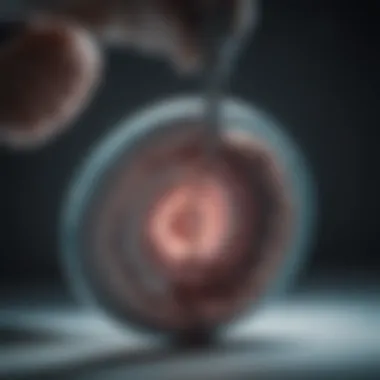
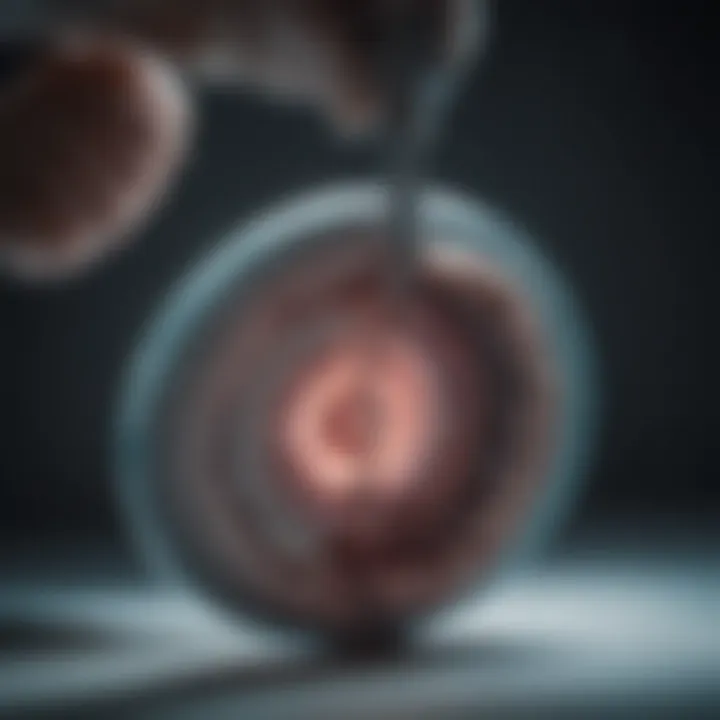
Epidural Steroid Injections
Epidural steroid injections are a common advanced treatment for managing pain associated with lumbar disc rupture. This procedure involves injecting corticosteroids directly into the epidural space surrounding the spinal nerves. The primary goal is to reduce inflammation and alleviate pain. This method can provide substantial relief, particularly for radicular pain that extends down the legs due to nerve compression.
Benefits of epidural steroid injections include:
- Quick pain relief for many patients
- Minimally invasive approach
- Improvement in mobility and daily activities
While effective, it is crucial to consider potential side effects. These can include temporary worsened pain, infection, or, rarely, neurological complications. Thus, a thorough evaluation of each patient's condition is essential prior to administering this type of treatment.
Nerve Blocks
Nerve blocks serve as another significant advanced treatment option for patients experiencing severe pain from a ruptured lumbar disc. This technique involves injecting anesthetic agents near specific nerves that convey pain signals from the affected area. Nerve blocks can either be temporary or long-term solutions, depending on their application and desired outcomes.
The potential benefits of nerve blocks are numerous:
- Rapid relief from acute pain
- Ability to pinpoint the source of pain
- Facilitation of rehabilitative therapies following the block
However, patients should be informed of possible drawbacks, including discomfort at the injection site, weakness in the injected limb, or incomplete pain relief. Collaboration with a pain management specialist can optimize treatment plans and ensure that nerve blocks are utilized effectively for the patient's benefit.
"Advanced treatment options like epidural steroid injections and nerve blocks highlight the necessity for personalized care in managing ruptured lumbar discs."
Incorporating these advanced techniques into treatment protocols enables healthcare providers to address both the symptoms and underlying issues associated with lumbar disc rupture, enhancing overall patient outcomes.
Surgical Interventions
Surgical interventions represent a critical component in the treatment of ruptured lumbar discs, particularly when conservative measures fail to provide relief. Surgery may offer long-term solutions for patients who experience persistent pain, neurological deficits, or other complications resulting from a herniated disc. Depending on the severity of the condition, surgical procedures can alleviate pressure on the spinal nerves, restore function, and enhance the quality of life. The decision for surgery involves thorough evaluation by medical professionals and consideration of patient-specific factors, making it essential to understand both the indications and types of surgical procedures available.
Indications for Surgery
Surgical options for ruptured lumbar discs are indicated primarily when non-surgical treatments, such as physical therapy or medications, have not produced satisfactory results after a reasonable duration. Criteria for considering surgery include:
- Severe Pain or Disability: Persistent and debilitating pain that affects daily activities often necessitates surgical intervention.
- Neurological Symptoms: Weakness, numbness, or loss of bladder/bowel control indicate that nerves may be significantly impacted, calling for surgical solutions.
- Progressive Symptoms: Worsening neurological involvement or inability to perform physical activities can prompt the need for surgical action.
A proper assessment of these factors informs both the patient and the healthcare team, guiding decisions toward surgical intervention when necessary.
Types of Surgical Procedures
Surgical options vary based on the patient's condition and specific needs. Common types of surgical interventions include:
Discectomy
Discectomy involves the removal of herniated disc material that is pressing on spinal nerves. This surgical procedure aims to relieve pain and restore function. One key characteristic of discectomy is its minimally invasive approach. As a popular choice, discectomy effectively decreases nerve compression, leading to significant pain relief in many patients. The unique feature is the ability to target only the affected area while preserving as much healthy tissue as possible. While the advantages include rapid recovery times and reduced scarring, potential disadvantages exist, such as the risk of recurrent herniation.
Laminotomy
Laminotomy entails removing a small portion of the lamina, the bony part of the vertebrae that covers the spinal canal. This procedure aims to alleviate pressure on the nerve roots. The key characteristic of laminotomy is its ability to provide direct access to the spinal canal with minimal disruption to the surrounding structures. This option is particularly beneficial for patients with regional nerve compression. One unique feature is its capacity to complement discectomy, providing additional relief for complex disc issues. However, disadvantages may include longer recovery times and a potential risk of instability in the spine.
Spinal Fusion
Spinal fusion involves joining two or more vertebrae together to stabilize the spine after disc removal or injury. This is often indicated for patients with significant spinal instability. A primary characteristic of spinal fusion is its ability to provide long-term stability to the affected area. This procedure is beneficial for patients with chronic conditions or complex disc issues, ensuring that vertebrae do not move independently. The unique aspect of spinal fusion is the potential for decreased pain and improved function over time. However, one must consider potential disadvantages, such as a prolonged recovery period and the possibility of adjacent segment disease, where neighboring discs may deteriorate after surgery.
"Surgical interventions should always be considered carefully, weighing the potential benefits against the risks involved in the procedure."
In summary, surgical interventions can be pivotal for patients suffering from ruptured lumbar discs. Each type of surgery presents distinct characteristics, which can suit various patient needs. Understanding the indications and types of surgical procedures informs better treatment planning and enhances the overall recovery process.
Post-Treatment Rehabilitation
Post-treatment rehabilitation plays a crucial role in the recovery process following a ruptured lumbar disc. This phase focuses on restoring function, alleviating residual symptoms, and preventing future complications. Effective rehabilitation can significantly enhance the patient’s quality of life by improving mobility and strength, which are essential for everyday activities. It is also important to recognize that rehabilitation is not a one-size-fits-all solution; it requires careful tailoring to meet individual needs and circumstances.
Rehabilitation Goals
The primary goals of rehabilitation after a lumbar disc rupture include the following:
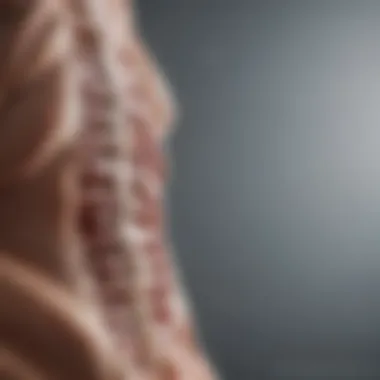
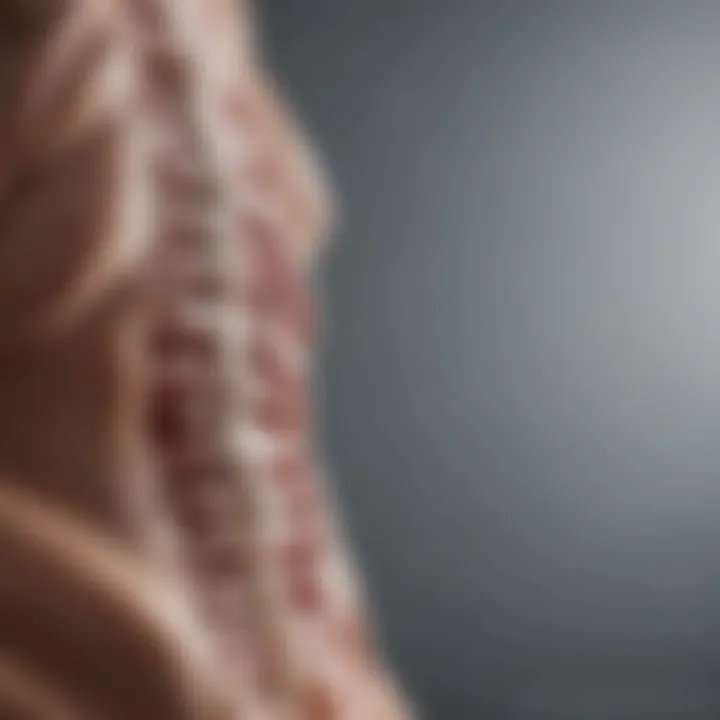
- Restoration of Function: Helping patients regain their previous level of activity. This includes the ability to perform daily tasks with minimal pain.
- Pain Management: Reducing any remaining pain through targeted therapies and exercises.
- Strength Development: Improving the muscular support around the spine to help prevent further incidents of injury.
- Enhancing Flexibility: Increasing the range of motion in the lumbar region and surrounding areas to reduce stiffness and encourage movement.
- Education on Body Mechanics: Teaching patients how to move and lift properly to avoid additional stress on the spine.
These goals work together to facilitate a holistic recovery process. By focusing on these areas, rehabilitation helps to not only recover physically but also to address psychological factors, such as anxiety related to movement post-injury.
Rehabilitation Techniques
Rehabilitation techniques are varied but primarily encompass two key areas: strengthening exercises and flexibility training. Both of these techniques contribute to the overall aim of restoring health and function.
Strengthening Exercises
Strengthening exercises aim to fortify the muscles that support the lumbar spine. These exercises are essential for stabilizing the spine and preventing future injuries.
- Key Characteristic: They typically focus on the core musculature, which includes abdominal and back muscles. Strong core muscles provide better support and balance to the spine.
- Benefits: These exercises are beneficial as they can be adapted to various fitness levels. A well-implemented strengthening program can lead to improved posture and reduced pain levels.
- Unique Feature: Strengthening exercises often incorporate resistance training, allowing for increased intensity as the patient's condition improves.
- Advantages: Improved stability and functional ability.
- Disadvantages: If not done correctly, there is a risk of injury.
Flexibility Training
Flexibility training is an equally important component of rehabilitation. It contributes significantly to the overall goal of restoring range of motion.
- Key Characteristic: Flexibility training typically involves stretching exercises that target not just the lumbar region but also the legs and hips to create a more comprehensive approach to mobility.
- Benefits: This training is popular because it can help reduce muscle tension and improve circulation, which is crucial for healing.
- Unique Feature: Flexibility training often utilizes dynamic and static stretches aimed at enhancing mobility.
- Advantages: Increased flexibility can lead to improved performance in daily activities.
- Disadvantages: Excessive flexibility can occasionally lead to joint instability.
Rehabilitation after a ruptured lumbar disc requires a comprehensive approach. By combining strengthening and flexibility training within the rehabilitation program, patients can expect significant improvements in both strength and function. The interventions must remain tailored to the individual to maximize their effectiveness. By staying engaged in the rehabilitation process, patients can better restore their health and overall well-being.
*"Individualized rehabilitation not only addresses the specific needs of each patient but also enhances their commitment to the rehabilitation process."*
For further information about lumbar disc conditions, you can explore additional resources on Wikipedia.
Long-Term Outlook
Understanding the long-term outlook for individuals who have experienced ruptured lumbar discs is essential for both patients and healthcare providers. This knowledge helps to set realistic expectations and guide management strategies post-injury. Long-term outcomes can significantly impact a patient's quality of life, emotional well-being, and ability to perform daily activities. It is imperative to consider various elements that contribute to recovery and prevention of recurrence.
Prognosis for Recovery
The prognosis for recovery from a ruptured lumbar disc varies based on several factors. Most patients report substantial improvement in symptoms, particularly when conservative treatment is pursued initially. Research shows that approximately 80-90% of individuals find relief through nonsurgical methods within a few months. Key factors influencing recovery include:
- Age: Younger individuals often have better outcomes due to higher disc hydration and healing potential.
- Severity of Damage: The extent of the rupture and nerve involvement impacts recovery time.
- Treatment Approach: Adhering to prescribed rehabilitation and adjusting lifestyle factors can enhance recovery.
- Patient Compliance: Following medical advice and attending follow-up appointments are crucial for monitoring progress.
The path to recovery often involves a phased approach, allowing for gradual reintegration into normal activities. After appropriate treatment, most patients can expect to resume most daily activities, although some may continue to experience mild pain or discomfort.
Risk of Recurrence
The risk of recurrence is an important consideration in the long-term outlook for patients with ruptured lumbar discs. Studies indicate that between 5-20% of people may experience a reherniation or develop another disc herniation. Several factors can heighten the risk of recurrence:
- Previous History: A personal history of disc issues increases the likelihood of future problems.
- Lifestyle Choices: Inadequate physical activity, poor ergonomics, and obesity can contribute to re-injury.
- Inadequate Rehabilitation: Failing to complete a comprehensive rehabilitation program can leave patients vulnerable to further issues.
- Genetic Predisposition: Some individuals may have a genetic tendency towards lumbar disc disease.
To mitigate these risks, strategies can include ongoing physical therapy, weight management, and ergonomic interventions. Awareness and proactive measures can minimize the chance of recurrence, allowing individuals to maintain an active and fulfilling life.
"Understanding long-term outcomes is not just about recovery, but also about preventing future issues through informed lifestyle choices and rehabilitation."
In summary, the long-term outlook for those recovering from a ruptured lumbar disc is generally positive, but vigilance is necessary to manage recovery and prevent relapse. Patients should remain engaged in their treatment process, seeking guidance and support from healthcare professionals to maintain their spinal health.
Closure
Concluding this exploration of treatment strategies for ruptured lumbar discs reveals the multidimensional nature of managing this condition. The significance of understanding various treatment options cannot be overstated. Each patient's circumstances are unique, and thus, providing personalized care is essential in achieving effective outcomes.
Summary of Treatment Options
In summary, treatment options for ruptured lumbar discs can be broadly categorized into conservative and surgical methods. Conservative management includes physical therapy, medications, and lifestyle modifications. Physical therapy aims to strengthen muscles and improve flexibility, while medications help with pain management and inflammation. Lifestyle modifications, such as ergonomic adjustments and activity alterations, are critical for daily functioning. Surgical options become relevant when conservative approaches fail or when specific neurological deficits ensue. Procedures like discectomy, laminotomy, and spinal fusion are available, each addressing distinct anatomical issues and symptomatology.
Future Directions in Treatment Research
The future of treatment for ruptured lumbar discs looks promising, with ongoing research aimed at refining current approaches. Advancements in minimally invasive techniques may reduce recovery time and enhance patient outcomes. Furthermore, studies exploring biologic therapies, such as stem cell applications, could offer innovative solutions to repair damaged tissue. The integration of technology, including telemedicine for follow-ups and virtual rehabilitation, shows great potential. Such developments underline the necessity for continuous evaluation and adaptation of treatment strategies to ensure they meet clinical needs effectively.
"The complexity of lumbar disc pathology demands a well-rounded approach that includes both advanced surgical options and robust conservative treatment pathways."
As the field evolves, emphasizing research that prioritizes patient-centered care will be pivotal in addressing the challenges faced by individuals with lumbar disc issues.



